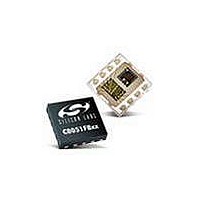Si1120-A-GM Silicon Laboratories Inc, Si1120-A-GM Datasheet - Page 11

Si1120-A-GM
Manufacturer Part Number
Si1120-A-GM
Description
Industrial Optical Sensors Proximity/Ambient Light Snsr w/PWM Out
Manufacturer
Silicon Laboratories Inc
Type
Ambient Light Sensor with Analog Outputr
Datasheet
1.SI1120-A-GM.pdf
(20 pages)
Specifications of Si1120-A-GM
Product
Integrated Ambient Light and Proximity Sensor
Output Type
Analog - Voltage
Maximum Operating Temperature
+ 85 C
Minimum Operating Temperature
- 40 C
Lead Free Status / RoHS Status
Lead free / RoHS Compliant
Available stocks
Company
Part Number
Manufacturer
Quantity
Price
Part Number:
Si1120-A-GMR
Manufacturer:
SILICON LABS/èٹ¯ç§‘
Quantity:
20 000
Si1120
2.4. Ambient-Light Modes
Proximity offset and gain can be affected a few percent by high ambient light levels (e.g. sunlight or strong
incandescent lighting). While the cal mode can be used to determine offsets from large ambient light or ambient
noise levels in PRX400 and PRX50 modes, direct measurement of the ambient levels can help identify whether
changes in reflectance are valid or in fact due to large ambient light changes. Usually, this is only an issue in high
reflectance situations, such as single window operation without good optical isolation, where large changing
ambients are an issue.
The Si1120 has two photodiodes, each of which peaks at a different wavelength. The VAMB mode uses the visible
light photodiode which peaks at around 530 nm. On the other hand, the VIRH and VIRL modes use the photodiode
which peaks at around 830 nm. Although the visible-light photodiode peaks near 550 nm (considered the peak
wavelength of human perception), the Si1120 visible photodiode extends to infrared light as well. Similarly, the
Si1120 infrared photodiode detects infrared light as well as part of the visible light spectrum. The Si1120 treats
ultraviolet, visible, and infrared light as a continuous spectrum.
The ratio between the visible and infrared photodiode readings provides a good clue to the type of light source. The
reason is that each light source consists of a characteristic mix of infrared and visible light. For example, blackbody
radiators, such as incandescent or halogen lamps, can have significant energy in the infrared spectrum. On the
other hand, fluorescent lamps have more energy in the visible light spectrum. The term “color ratio” will be used to
describe the relative strength of the visible photodiode reading relative to the infrared photodiode reading. Human
color vision employs a similar principle.
The VAMB/VIRH or VAMB/VIRL color ratios are representative of the Si1120's color perception. Choosing between
these two color ratios depends on the light intensity. In general, VAMB/VIRL should be used first since VIRL has
higher sensitivity. For higher light intensities, the VAMB/VIRH ratio should be used.
Note that VAMB, VIRH, and VIRL pulse widths are used as dividends and divisors in these ratios. What this means
is that the pulse width offsets (at 0 lux) need to be removed prior to usage in the above color ratios. For best
precision, it is best to take VAMB, VIRH, and VIRL measurements at 0 lux and to use actual measured values.
However, a good rule of thumb is to subtract 7.1 µs, 11.3 µs, and 9.9 µs respectively from VAMB, VIRH, and VIRL
(then assigning 0 µs to any resulting negative value). This rule-of-thumb can be used when accuracy is less critical.
Unless stated otherwise, the plots and figures used in this data sheet use offset-corrected values for VAMB, VIRH,
and VIRL.
Once a color ratio has been derived, the light type(s) and lux ratios are also identified. The lux ratio describes the
ratio between the desired lux value and VAMB, VIRL, or VIRH (depending on the situation). The appropriate lux
ratio, when multiplied with the applicable measurement, yields the final calculated lux value. Without any
calibration, it should be possible to arrive within 50% (or 50 lux) of the absolute lux value.
Figure 8. Ambient Light Mode Timing Diagram
Rev. 1.0
11











